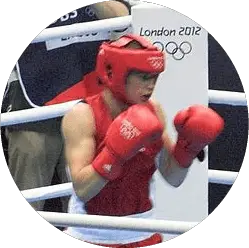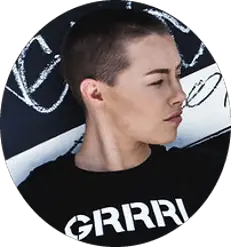Martial arts has long been dominated by male teachers, students, and movie stars. But there are actually a huge number of benefits for women who do martial arts. But with so many different styles to choose from, what is the best martial art for women?
The best martial art for women looking for self-defense skills would be 1. Krav Maga, 2. Muay Thai, or 3. Brazilian Jiu-Jitsu. Karate or Tai Chi are better for those less comfortable with violence or close physical contact.
And for women looking for a strong spiritual component, Aikido is a great choice. So ultimately, the best art depends on the goal of the woman.
In helping run a large martial arts school for most of the past decade, I’ve seen hundreds of female students both children and adults.
But let’s face it.
While the average woman is not likely to find themselves in a street fight, women can sometimes find themselves in dangerous situations and can be at risk of sexual assault. And so learning how to defend themselves is the best way to stay safe.
The world can be a dangerous place.
Some love the close physical contact of Brazilian Jiu Jitsu (BJJ), but it’s not uncommon, especially with teen girls, for them to NOT like wrestling, especially with boys their same age. I also have 3 daughters, the older 2 of which did martial arts for years.
The irony is that BJJ can really help with self-esteem, core strength, focus, and resilience.
So in this article, we’ll get into all the details, and questions, and take an in-depth look at many top martial arts styles so you can decide for yourself which is best for you.
Let’s get started!
Afghan women practice ancient Shaolin martial arts https://t.co/0SZlV32RHz via @AP_Images #photography #photo pic.twitter.com/qrvNY9YVVO
— Jonathan Christian Photography (@JonathanCRiley) February 2, 2017
So let’s review the best martial arts for women
1. Krav Maga
Krav Maga isn’t really a martial art.
Instead, it’s a self-defense system that is focused purely on incapacitating an attacker as quickly and easily as possible with as little risk of harm to oneself as possible. But it’s a great option for a woman or teen girl who wants to quickly get good at basic self-defense movements and techniques.
Krav Maga keeps it simple with things like groin kicks, eye gouges, etc. And you learn situational awareness, which is key to avoiding conflicts or potentially violent situations in the first place.
It was developed by the Israeli military and is now practiced worldwide. It focuses on teaching simple techniques without any spiritual component and without choreographed movements.
So Krav can be mastered a lot faster than more traditional martial arts.
2. BJJ
Brazilian Jiu-Jitsu blends traditional Japanese Judo and Jiu-Jitsu with a keen focus on helping smaller and lighter people defend themselves against heavier or larger opponents.
It is mostly done on the ground and to the untrained eye, looks a lot like wrestling. So some women or especially teenage girls may be uncomfortable training with a man.
But there’s no doubt it’s incredibly effective.
That being said, violent attacks don’t always go to the ground. And especially if there are multiple attackers, you don’t want to end up on the ground. After all, it’s far easier to defend yourself against multiple people, or get away, if you are on your feet.
So as much as I love Jiu-Jitsu, it’s not ideal for every self-defense situation unless the school also teaches stand-up self-defense.
3. Muay Thai
Muay Thai is quite the workout!
And you’ll be learning a combination of moves that basically blend boxing and kickboxing. Knees, elbows, punches, and kicks are the name of the game here.
I would typically suggest this for those who are already somewhat fit, and on the younger side. But it’s a great option for women’s self-defense, and great for overall physical fitness.
4. Karate
Karate is a good choice for those who want less contact with training partners but still want to know some techniques that could be used for self-defense.
Punches, blocks, kicks, and traditional kata forms (think choreographed solo dance moves), are all a big part of it. But being a traditional Japanese martial art, there will be a key focus on discipline as well.
My only hesitation is that not everything you learn in Karate will help in potentially dangerous situations. But as I often say, knowing ANY martial art is better than not knowing any.
5. Tai Chi
Tai Chi admittedly is pretty weak from a self-defense standpoint.
Not that it can’t be used in a more martial application (my teacher Sensei Gene Smithson could trounce any attacker using only Tai Chi moves if he chose to).
But for most of us, Tai Chi will be more for someone who is looking for a solo practice that is easy to learn (if you do the short form), gentle on the body, but is as beneficial for the mind and body as both yoga and meditation are.
It can be part of an overall healthy lifestyle, and there’s no doubt that a calm and centered mind that is focused on the present moment is less likely to find themselves in a physical altercation.
7. Aikido
Aikido sometimes gets a bad rap for being too peaceful or too gentle.
Trust me. Once you’ve been thrown by an Aikidoka or had a wrist or joint lock employed on you, you won’t think it’s gentle anymore.
But there is an underlying “do-no-harm” philosophy, making it a great choice both for a woman looking for self-defense skills and for whom a peaceful philosophy is important.
But that “do-no-harm” ethos doesn’t mean you can’t defend yourself. It simply means you would only hurt another as a last resort, and you would do as little harm as possible before being able to escape.
8. Taekwondo
Taekwondo sometimes gets a bad rap as some schools give out black belts like Halloween candy. And other schools focus purely on the sports aspects.
But the right Taekwondo school will be an excellent place to learn self-defense skills.
And while it’s true Taekwondo focuses heavily on kicking, you will also learn punches and other excellent self-defense moves too. But if defending yourself is the primary goal, I would look for a school where competitions and tournaments are downplayed and the focus is on self-defense.
Taekwondo can allow girls to practice safely while also learning invaluable self-defense skills.
9. Judo
Judo is not unlike both BJJ and Aikido in that you’ll learn throws, joint locks, but also do a lot of ground movement.
Ronda Rousey (featured below) is one of the best fighters in the world and Judo is her #1 martial art. Like Taekwondo and now Karate, Judo is also an Olympic sport, so look for a school that focuses more on self-defense unless the sport aspect appeals to you.
Typically classes of any art that are purely focused on sport are less effective for self-defense given all the rules practitioners are expected to follow.
One thing I do like about Judo is there is a slightly better balance between standing and ground movements compared to BJJ.
10. Wing Chun
Wing Chun is one of the many martial arts that fall under the generic term “Kung Fu” which basically describes all Chinese martial arts.
But Wing Chun is a fighting style unlike some of the gentler styles of Kung Fu such as Tai Chi.
Wing Chun was also what Bruce Lee started with. Eventually, he formed his own system called Jeet Kune Do which blended Wing Chun with other systems. But if you’ve watched some Bruce Lee fight scenes, you are seeing a lot of elements of Wing Chun.
The foundation of Wing Chun is a heavy focus on lightning-fast punches, kicks, and blocks.
11. Tony Blauer’s SPEAR system
This, like Krav Maga, isn’t a martial art.
But for women looking to defend themselves, it definitely needs to be on the list. Tony’s system basically calls for using your natural responses and reflexes to an attack as a means for a quick counter-attack. So compared to a lot of martial arts which can sometimes rely on choreographed movements, SPEAR is very free-form.
It’s now used extensively by UK police officers.
So if you’re looking for something down and dirty, easy to learn, that is incredibly effective against would-be attackers, this is well worth considering.
Frequently Asked Questions
What is the best martial art for short girls?
For shorter girls and women, the best martial arts styles include Aikido, BJJ, Judo, and Wing Chun as they are designed for smaller, lighter practitioners and the techniques use an attacker’s energy against them rather than requiring brute strength or size.
But I might also suggest that it’s better to master at least two “complementary” martial arts.
Let’s consider an attack. Perhaps it’s a mugger who’s simply interested in snatching your purse and in scaring you into submission. One of the martial arts (or similar ones) I suggested above will work. In essence, you need minimal skills and tactics to fend the attacker off.
But suppose it’s a life-threatening scenario; maybe multiple people with knives.
Those styles may still be adequate, but if you also knew some Krav Maga or Muay Thai you would be able to neutralize the attacker(s) that much quicker. And the shorter the fight, the lower the risk of injury to yourself.
These latter arts are deadly. And Krav Maga actually comes from the Israeli military.
They’re what you need when you’re unfortunate to be in a situation where your attacker is deadly. The martial arts help turn you into a fierce warrior who can destroy most attackers. And, I do not mean destroy in a metaphorical sense.
’You probably heard of Aikido and BJJ.
Which is more effective for self-defense? A recent article of mine provides the answer. Really, while I like and have practiced both, one is clearly better than the other if we’re talking self-defense.
Just click the link to read it on my site.
How can a woman decide which martial art is for her?
To decide which martial art is right for her, women need to pick a goal, which can be self-defense, building confidence, strength training, or losing weight. Then watch videos of specific styles. Finally, take a free trial class at 1 or more dojos, as the teacher is often more important than the style itself.
So let’s examine those steps in greater detail:
-
Clarify Your Goals
It seems like a no-brainer, but this is the first step.
Why are you interested in martial arts? It’s a tad like picking up the right dress. The “right dress,” you’ll agree, depends on the woman, the occasion, and her budget, right?
Most martial arts are not “one thing”. They’re holistic systems consisting of several dimensions. They have physical, mental, spiritual, emotional, and philosophical components.
And there can be a big difference between a Japanese martial art, a Korean martial art, a women’s self-defense workshop, or something that focuses more on being an Olympic sport.
Are you interested in an activity that’ll provide a way to connect with and bond with like-minded women?
Are you trying to work on your confidence? Are you trying to acquire self-defense skills? Or are you interested in merely researching these arts?
All are valid goals.
And, there’s nothing wrong with having all of them. But, it’s helpful to clarify your intent because that clarity would make choosing a lot easier. Now that you’re clear about what you want, it’s time to conduct due diligence.
-
Do Due Diligence
Google is great, right?
We have virtually all the info we need about most subjects at our fingertips. So, spend some time doing research online. There are many great sites where you can access information about all martial arts.
If you’re someone who loves doing deep-dives, you could even buy a couple of books.
Naturally, you’ll find more info in books than on websites. Listen to podcasts. Watch YouTube videos. In days or weeks, you’d have enough info that’ll help you make the right choices.
You’ve done the conceptual facet of the due diligence phase. Just don’t get stuck in analysis-paralysis. Do enough research to get some basic knowledge and then go try a class; that’s the only way to be sure if it’s right for you.
Now let’s take the martial art for a test-drive.
-
Try a class (or 3)
Most schools allow you to check out their training for a free class or 2 to decide if it’s the right choice for you.
If they won’t, keep moving as there are lots that do. Ideally in the step above you would have narrowed down the styles to 2-4 different types. Now you should go and do a free trial class at a dojo in each of the styles that looked like a good fit.
After all, what better way is there to know and ask questions from those who are really in the game? Besides talking to the instructors, you could talk to the students to learn more about the style and the school.
And as I mentioned above, the right martial art with a bad instructor won’t help you at all; a great instructor is key and ultimately more important than the style.
It’s OK to be challenged and pushed by an instructor. But run if you find one that’s mean, insulting, condescending, or knocks people down instead of building them up.
“@AikidoCentral: #aikido Aikido women – Dan Examination – http://t.co/vg9dzIlocP pic.twitter.com/RNfbGfzHEB”
— samama (@HenrySev) August 14, 2014
Should every woman learn self-defense techniques to protect herself?
Every woman should learn how to defend themselves against an attacker. 1 in 3 women will be or have been a victim of violence. And self-defense techniques can mean the difference between life and death.
It’s sad, but violence against women occurs even in some intimate relationships!
Even when the situation is not life-threatening, there are attacks that leave some women with indelible scars or crippled!
Some attacks, such as rape, make the victims vulnerable to sexually transmitted diseases, unintended pregnancies, abortions, genealogical problems, even HIV.
Consider: The World Health Organization (WHO) shows that 1 in 3 women (worldwide) have been victims of violence. Most of these are committed by partners in an intimate relationship. 38% of murders of women are committed by a male intimate partner. (source)
It went on to show that “Almost one third (30%) of all women who have been in a relationship have experienced physical or sexual violence by their intimate partner.”
Now.org shows that 600 women are raped or sexually assaulted each year. And that an average of 1 in 3 women are murdered each day by an intimate partner!!!
At the risk of stating the obvious, this is not only sad, but it’s also shocking. The above stats do not reflect the whole truth because a lot of cases go unreported.
Now, we know that no woman goes into a relationship, thinking that she’d be attacked by a lover someday or that a date could turn into a nightmare. Unfortunately, these are real-life situations.
Or that a simple walk in the park could turn deadly. And let’s be honest, the average woman just doesn’t have the same level of upper body strength that the average man does.
So, the smart thing to do is to be proactive. It’s good to have positive thoughts and all. It’s good to also avoid dangerous people and environments. And it’s wise to complement that with having superb self-defense skills.
But at the very least carry pepper spray. But the ideal would be to also have the physical training also.
This is not to suggest that women ought to become aggressive or violent or that they should ignore relationships. It’s about being equipped with the skills to protect one’s life. The most precious gift we all have.
Judo or BJJ, which one is ideal for self-defense?
That’s what I explored in a recent article of mine. I shared vital info about each and advised on which one to choose. One is clearly better, which is ironic considering one came from the other.
Just click the link to read it on my site.
The Heavyweight Women! 2 awesome French Gold Medallists#JudoMasters #Judo @qatar_olympic
© IJF Media Team – Marina Mayorova pic.twitter.com/8UtgQCOkcV
— Judo (@Judo) January 13, 2021
Does women’s self-defense work?
Yes, women’s self-defense techniques definitely work better than if the woman was untrained. For women who may be smaller or lighter, BJJ, Krav Maga, or Tony Blauer’s SPEAR system can be especially effective.
And unlike martial arts training, which can take years to perfect, most self-defense workshops and classes are designed to teach a basic fighting style comprised of just a few easily-learned key moves.
But a skeptic could say that most men are usually taller and bigger and that that gives them an advantage over women. But it really isn’t because most martial arts are not really about height or weight.
Take Israel Adesanya, an MMA champ, for example.
He’s not a big dude, and yet, he trounces bigger, more macho, and more deadly fighters. Self-defense is really about brains, not brawn. If you study his fights, you’ll notice that he’s super-alert (he dodges most blows and kicks), flexible, and swift.
He dodges and dodges and waits for the perfect opportunity, then he attacks.
In fact, the essence of some martial arts is leveraging the attackers’ strengths against them. Ideally, a woman should learn MMA techniques so that they can use a variety of techniques to protect themselves, no matter their size or weight, or even how physically fit they are.
And if you’ve ever seen Ronda Rousey fight, you wouldn’t even ask the question.
If a woman learns Muay Thai or Krav Maga, they’d know how they can use “mundane” techniques to incapacitate their opponents by using parts of their bodies as weapons.
Let’s say a woman is being attacked.
If she’s learned traditional martial arts such as Aikido or Judo, she could easily throw the attacker. Unless the attacker is trained, they’d probably break a bone and just lie on the ground. She could also use her knees and elbows as lethal weapons. How?
Imagine that the attacker is trying to wrestle the woman to the ground.
After all, ground fighting happens. And with the likely disadvantage of body weight, a woman should do anything to avoid having a male attacker on top of her.
She could aim her knee at his groin and her elbow at his eyes. The knee, when properly used, can take down the most deadly attacker. It’s one of the most effective weapons “The Last Style Bender” (Israel Adesanya) uses in virtually all his fights.
There’s hardly any man alive that can’t be subdued with a forceful kick to the groin and being blinded at the same time.
At this point, the best thing is to flee. That’s the best defense: to flee to safety.
Muay Thai girls power !!! 🤩 💛🖤💛🖤come to get fit and learn some Muay Thai skills at @sutaimuaythai 🏝 pic.twitter.com/tU2Dpo8WCj
— SutaiMauyThai (@MauySutai) January 7, 2020
Are there any martial arts created by a woman?
A woman named Ng Mui, a Shaolin nun created and popularized Wing Chun, a specific style of Kung Fu popularized by Bruce Lee before he started his own variation called Jeet Kune Do.
She developed it when she felt that most martial arts might be difficult for short women. It’s named after her first student, a woman named Yim Wing Chun.
Of course, as I have shown above, women can employ martial arts, irrespective of their height. Height and weight aren’t the defining factors in martial arts. It’s actually the mastery of the techniques that determines who wins.
So, what’s Wing Chun, and what makes it particularly effective for women?
As I said, Wing Chun is the form of Kung Fu that Bruce Lee, the most famous martial artist, employed. Before we go on, it’s vital to let you know that the term Kung Fu does not really mean martial art. In Chinese, it can be loosely translated as hard work.
Now, Wing Chun seeks to take advantage of limitations inherent in some martial art forms.
And it’s ideal for women because anyone can use it irrespective of their size or athletic ability. It can be learned in a short time, and it’s intensely practical.
It’s based on the assumption that one is being attacked and is focused on defending and attacking at the same time by exploiting human anatomy.
It’s sneaky. It’s “brainy”, seeing as the focus is not on physical strength but on using minimum to gain maximum effect.
It has three key components:
- The ‘centerline’
- Attacking and defending at the same time
- Minimal motion in execution
The second and third components are self-explanatory. The ‘centerline’ is about focusing on the pressure points in the body.
We’ve had an overview of a martial art developed by a woman.
It’s interesting to check out the best martial art for teenage girls. In a recent article of mine, I suggested the ideal one. Teenage girls, after all, are changing phsyically and hormonally. So their needs can be very different than those of an adult woman.
Just click the link to read it on my site.
We love launching products, especially when it features one of our favorite athletes! Our team supported the launch of Mizuno’s Inaugural Ronda Rousey Training Apparel Collection, designed and developed by Mizuno’s design team. Check out the full line at https://t.co/qd5ZORvJM9. pic.twitter.com/L6nGB9FScw
— Brandware Group (@BrandwareGroup) January 12, 2021
Who are the best female martial artists?
Let’s check out 7 amazing female martial artists:
- Gina Carano (Actress in The Mandalorian, and MMA fighter)
- Ronda Rousey (MMA fighter and WWE wrestler)
- Kacy Catanzaro (WWE Wrestler and American Ninja Warrior finalist)
- Katie Taylor (won an Olympic Gold Medal in boxing)
- Sarah Koffman (MMA fighter)
- Rose Namajunas (MMA fighter)
- Valentina Shevchenko (MMA fighter)
Now let’s look at each of those in greater detail:
Gina Carano 
Gina Carano has starred in some awesome movies such as Fast and Furious, Deadpool, and my personal favorite TV show, The Mandalorian.
But she’s not just an actress.
She used to be an MMA fighter (Yeah, the real deal). She started learning Muay Thai when she was 21 and eventually parlayed that into competing in the Octagon and starring in movies.
Ronda Rousey 
Ronda Rousey is an actress and professional MMA fighter.
She’s a judoka and wrestler who’s currently signed to WWE as a wrestler. She’s the first American woman to win an Olympic Gold Medal in Judo. It was after this victory that she went into MMA (Mixed Martial Arts).
She’s also known for being brutally fast; I saw one of her matches that she won in just 14 seconds!
Kacy Catanzaro
OK, I can hear the criticisms already; she’s not technically a martial artist.
She is, however, a WWE wrestler (now retired), an amazing athlete, an inspiration to many, a great role model for young women, and the 1st woman to qualify for the finals of the American Ninja Warrior TV show. And also the first woman to complete a City Finals course with ANW.
So she’s badass and deserves to be here.
Katie Taylor 
Katie Taylor is another one that’s technically not a martial artist.
She is, however, a professional boxer, and a two-weight world champion, including her current title of undisputed lightweight champion.
She won the Olympic gold medal in 2012 and won the gold medal more than 15 times at the Women’s World Championships and European Championships!
In fact, it’s rumored she’s the richest female boxer in the world.
Sarah Kaufman 
Sarah Kaufman is a Canadian MMA fighter.
She’s a kickboxer and BJJ fighter who’s won 21 fights and has lost only 5. She signed up with UFC in 2013 but was dropped after her loss to Valentina Shevchenko in 2015.
Despite that loss, and a loss to Ronda Rousey I listed above, she’s still an amazing martial artist with an impressive track record, and she clearly deserves to be on the list of top female martial artists.
Rose Namajunas

Rose Namajunas is an American professional mixed martial artist.
She is part of the Ultimate Fighting Championship (UFC). She competes in the women’s strawweight division. Rose is badass and is a two-time and current UFC Women’s Strawweight Champion.
As of the time of this writing, she is ranked #3 in the UFC women’s pound-for-pound rankings.
She has a black belt in Tae Kwon Do (earned at age 9). She started training in martial arts at age 5.
She has additional training in Karate, BJJ, and Kickboxing.
Valentina Shevchenko

Valentina Anatolievna Shevchenko is a Russian professional mixed martial artist and former Muay Thai fighter.
She competes in the women’s Flyweight division for the Ultimate Fighting Championship (UFC).
Currently, as of this writing, she is the UFC Women’s Flyweight Champion.
Shevchenko became champion at UFC 231 after defeating Joanna Jędrzejczyk. As of this writing, she is ranked #1 in UFC women’s pound-for-pound rankings.
Born to a mom who was a Muay Thai champion, Shevchenko started Taekwondo at age 5 but also has extensive training in Muay Thai, Vale Tudo, kickboxing, and boxing.
One of the classes that we offer is Tapout Fitness Kids’ Martial Arts! Our kids’ and adults’ Martial Arts classes are designed by Master Coach Greg Jackson, but in our kids’ classes, we want to help kids with great life skills, including self-confidence, focus, and self-defense. pic.twitter.com/9lijqghNtS
— Tapout Fitness International (@gotapoutfitness) September 20, 2020
What age is best for a woman to start martial arts?
A woman would ideally start practicing martial arts between the ages of 5 and 9 so that the movements and situational awareness will be second nature as they head into their teen years. But martial arts can be started at any age.
(source)
Young women ages 16-19 are 4 times more likely to be sexually assaulted.
We know one indisputable truth, the longer we practice anything, the greater the possibility that we’ll be good at it.
We know that a person who’s been practicing how to play the violin for twenty years is most probably going to be better than someone who’s only played for two years.
It’s the same in martial arts. The earlier, the better.
Ideally, a woman can start practicing martial arts at the age of 5. It’s not advisable to start at a younger age because the body is not yet strong enough. Plus younger than 5, and really under age 7, it’s not uncommon for kids to lose interest quickly and want to move on.
Once a child has moved on, it can be very hard to get them to come back to martial arts, even if they desperately need it.
Having said that, we know that the best time to plant a tree was 20 years ago, and the next best time is today.
So, it’s never too late—martial arts work, irrespective of the practitioners’ age, size, or height. Of course, being young, tall, and slim confers certain advantages. There’s no doubt about it. But, these arts are not about brute force. They’re actually about techniques and mindset.
I’ll cite the example of The Last Style Bender again.
A slim, average-looking fellow who has trounced more physically endowed and more formidable opponents by focusing on being highly defensive and waiting for the right opportunities to strike.
So, don’t think: “Oh, I am too old…I am overweight…I am probably at a disadvantage being a woman…” Don’t. The best martial arts teach you to turn limitations into strengths.
Disregard your limits and focus on acquiring the skills.
Jim Kwik, the iconic brain and performance coach, who trains some of the most successful folks on the planet, said something powerful: “If you fight for your limitations, you get to keep them.”
Conclusion
All smart women ought to learn how to defend themselves. This is because the rate of violence against women is so high.
How should a woman go about selecting the right martial art?
Which martial art is ideal for short women? Which one is great for women in general? Is there a martial art that was developed by women? Yes. Wing Chun.
At what age should a woman start learning? What is the most effective martial art for women? After all, there is a big difference between some of the popular martial arts and combat sports.
Who are the top female martial artists? All the questions were adequately answered in the article. It’s filled with in-depth and helpful suggestions for women seeking to protect themselves.
Photos that require attribution under CC2.0. Photos cropped and possibly lightened
Gina Carano iPhone wallpaper by xploitme
helpusronda by Darrell A. (public domain)
AFC II Aftershock – Strikeforce Women’s Welterweight Champion, Sarah Kaufman by The Photography Elf
Kacy Catanzaro, Dec. 2016.jpg by U.S. Army
File:Valentina Shevchenko.jpg by MMAnytt.se is licensed under CC3.0
